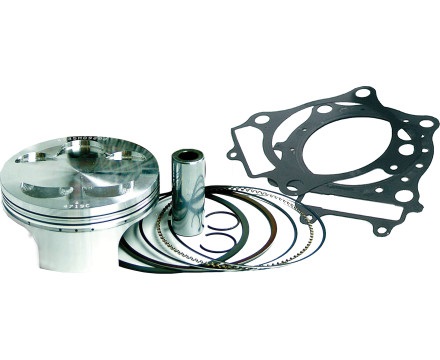
You may be ready to ride. Your dirt bike might look ready to ride especially after a quick detail and a tire pressure check. And, the weather most certainly says get out and ride.
But, after sitting in the garage or storage during the winter months do you think the engine is ready to ride?
In continuing our "Are You Ready to Ride" series we take a deeper look into those components that work in conjunction with each other to give you the best possible experience on your dirt bike. "Are You Ready to Ride" laid out more than a dozen checks you need to mark off before heading out to the track or trails so now we take a deeper dive and focus on individual units that help make the whole.
The mechanical wonder that forms a dirt bike engine contains dozens of different parts that work in unison. Just look at this setup which, when pieced together, turns into a complete engine rebuild kit:
None of this works very well for very long if left unattended so before pressing the start button or dropping the kickstarter make sure to cross these boxes off the checklist before putting a checkmark next to "Engine."
1. Spark plug
A bad spark plug prevents any combustion from happening inside the engine. If the engine won't turn over after sitting idle for the last few months you might need to replace the spark plug.
Shop for spark plugs.
2. Oil and Filter
If you did not change the oil and filter before setting your dirt bike aside for winter you need to do that now. You don't want all that dirty oil sitting in the bottom of the engine case to coat vital engine parts. Start fresh.
3. Top End
You remove the cylinder and head to give the top end a visual look but then you need to replace the gaskets. Instead, perform a compression test which demonstrates if the engine is ready to ride. Read "How To Do a Compression Test On a Dirt Bike or ATV" for more information. If the compression test fails spec then open the head/cylinder. Once inside, inspect the top end and power valve (2-strokes) and check for any slop or play in the rod.
Additionally, if you keep detailed maintenance records then you have an idea of where the engine stands on hours though it's not a bad idea to replace the top end now if the next ride day puts you near or at the regular service intervals.
Shop for top end kits.
4. Fresh Fuel
If you added fuel stabilizer to a full tank of gas you're good to go. If you drained the tank then fill 'er up with some fresh gas and not the stuff that sat in your garage the last four months. If you didn't add stabilizer to a full tank of gas, check to ensure the fuel has not turned and next year read "6 Tips for Dirt Bike and ATV Winter Storage."
5. Valve Clearance: 4-strokes only
So, I still need to remove the cylinder and head?! Like we said, if you plan on doing a top end, then yes, and while there, check the valve clearance. If you remain within service intervals on the valves and the top then get ready to ride. But, like the top end suggestion, if records show the valves might need adjusting then take a look. We always recommend checking the valve clearance when performing a top end anyway as noted in "How To Check Valve Clearance on a Dirt Bike or ATV."









